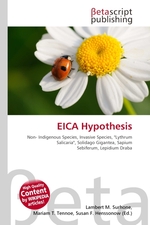EICA Hypothesis
Lambert M. Surhone, Miriam T. Timpledon, Susan F. Marseken
бумажная книга
High Quality Content by WIKIPEDIA articles! High Quality Content by WIKIPEDIA articles! The Evolution of Increased Competitive Ability (EICA) Hypothesis was first proposed by Bernd Blossey and Rolf Notzold in 1995 as a way to explain the success of invasive, non-indigenous species (in particular, plants). Observing that 1) there is usually a lag period between the time of introduction of an invasive species and the point at which it is considered invasive, and 2) invasive plants seem to be more virulent in habitats into which they have been introduced (as compared to their native habitats), the scientists presumed a sort of naturalization through modification for non-indigenous plants. Because of a lack of native predation, the scientists reasoned, introduced plants are able to reallocate resources from defense mechanisms into growth and development. Introduced plants can thereby evolve to grow taller, produce more biomass, and yield more viable offspring than their native counterparts, according to the hypothesis.
Данное издание не является оригинальным. Книга печатается по технологии принт-он-деманд после получения заказа.


